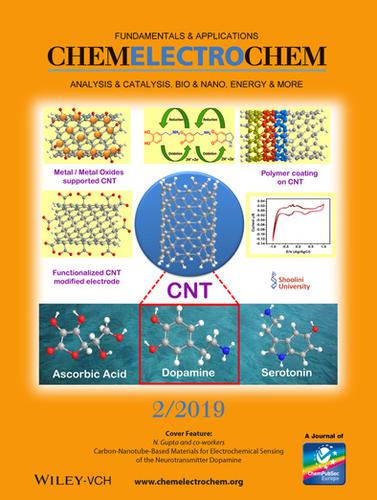当前位置:
X-MOL 学术
›
ChemElectroChem
›
论文详情
Our official English website, www.x-mol.net, welcomes your
feedback! (Note: you will need to create a separate account there.)
Cover Feature: Carbon‐Nanotube‐Based Materials for Electrochemical Sensing of the Neurotransmitter Dopamine (ChemElectroChem 2/2019)
ChemElectroChem ( IF 3.5 ) Pub Date : 2018-12-11 , DOI: 10.1002/celc.201801770 Kanchan Bala 1 , Deepika Sharma 2 , Neeraj Gupta 2
ChemElectroChem ( IF 3.5 ) Pub Date : 2018-12-11 , DOI: 10.1002/celc.201801770 Kanchan Bala 1 , Deepika Sharma 2 , Neeraj Gupta 2
Affiliation

|
The Cover Feature shows the detection of neurotransmitter dopamine in the presence of interfering chemical species, such as ascorbic acid and serotonin, using carbon nanotube (CNT)‐based materials. The highly conducting nature of functionalized CNTs, with large tensile strength, makes them an ideal non‐metallic material for the development of biosensors. Other modifications such as depositing metal or metal‐oxide nanoparticles on the CNT surface and coating polymers onto them can significantly increase their properties towards the detection of dopamine. Cyclic voltammetry can detect dopamine through its redox behavior over a wide potential range by using modified CNT electrodes. More information can be found in the Review by N. Gupta and co‐workers on page 274 in Issue 2, 2019 (DOI: 10.1002/celc.201801319).

中文翻译:

封面功能:用于神经递质多巴胺的电化学传感的碳纳米管基材料(ChemElectroChem 2/2019)
封面功能显示了使用基于碳纳米管(CNT)的材料在存在干扰化学物种(例如抗坏血酸和5-羟色胺)的情况下对神经递质多巴胺的检测。功能化的CNT的高导电性,抗张强度高,使其成为开发生物传感器的理想非金属材料。其他修饰,例如将金属或金属氧化物纳米粒子沉积在CNT表面上以及在其上涂覆聚合物,可以显着提高其在检测多巴胺方面的性能。循环伏安法可以通过使用修饰的CNT电极在很宽的电位范围内通过其多巴胺的氧化还原行为来检测多巴胺。有关更多信息,请参见N.Gupta及其同事在2019年第2期第274页上的评论。 (DOI:10.1002 / celc.201801319)。

更新日期:2018-12-11

中文翻译:

封面功能:用于神经递质多巴胺的电化学传感的碳纳米管基材料(ChemElectroChem 2/2019)
封面功能显示了使用基于碳纳米管(CNT)的材料在存在干扰化学物种(例如抗坏血酸和5-羟色胺)的情况下对神经递质多巴胺的检测。功能化的CNT的高导电性,抗张强度高,使其成为开发生物传感器的理想非金属材料。其他修饰,例如将金属或金属氧化物纳米粒子沉积在CNT表面上以及在其上涂覆聚合物,可以显着提高其在检测多巴胺方面的性能。循环伏安法可以通过使用修饰的CNT电极在很宽的电位范围内通过其多巴胺的氧化还原行为来检测多巴胺。有关更多信息,请参见N.Gupta及其同事在2019年第2期第274页上的评论。 (DOI:10.1002 / celc.201801319)。











































 京公网安备 11010802027423号
京公网安备 11010802027423号